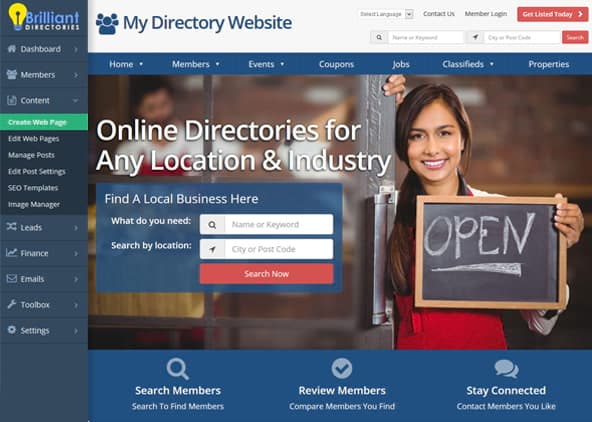
Key Topics:
- 2:27 – Admin Filters: Search Reviews and Members’ Leads by Date
- 4:02 – Webhooks: Send Smart List Contacts to Other CRM Solutions
- 6:45 – Redirects: Import 301 Redirect URLs with .csv File
- 9:00 – Images: New Recommended Image Size Settings
- 10:48 – Emails: Deliverability Improvements via Domain Authentication (July/August 2022)
- 11:09 – API: Ability to Import Feeds & Data INTO BD Sites via Zapier, Pabbly, etc. (July/August 2022)
- 12:27 – Newsletters: New Design & Workflow to Send Bulk Emails & Newsletters (August/Sept 2022)
- 12:36 – Tons More: Speed, security, quality-of-life features & exciting new releases on the way!
- 13:20 – Suggestion to search past or expired events
- 15:14 – Will websites be able to onboard new members with a Typeform form and have users search members based on the parameters in the Typeform form?
- 16:47 – Ability to use Jotform to implement conditional questioning?
- 19:08 – Webhooks: Automatically Share Website Content on Social Media
- 19:53 – Zapier & Other Webhook Integrations
- 21:44 – The Benefits of Automated Social Sharing
- 23:26 – A Few Things to Note…
- 25:33 – Set Up Automated Social Sharing for Posts
- 26:59 – Let’s Set Up Automated Social Sharing
- 49:36 – Suggestion to add internal notes when customizing forms, widgets, etc.
- 52:39 – Will the post auto-share webhook trigger if an admin approves a post?
- 55:00 – Will more data be passed through and available via webhooks?
- 56:45 – Use case for Global Website Search add-on
- 1:06:18 – How to manually curate content on a landing page?
- 1:09:45 – How to show a member’s sub-accounts on their profile page?
- 1:10:57 – Suggestion to optimize “Welcome, member” message for members with long names
- 1:12:29 – How to add an arrow icon on dropdown menu items?
New Features
Coming Soon
Tip of the Week
Questions & Answers

 AI-Generated Transcript – Please excuse any inaccuracies
AI-Generated Transcript – Please excuse any inaccuracies
Admin Filters: Search Reviews and Members’ Leads by Date (00:02:27)
- A new search filter has been added to the admin area, allowing users to filter reviews and member leads by date, which is a quality of life improvement (00:02:27).
- The new search filter can be found in the interaction section, under both member leads and member reviews, and includes a date range picker to search for reviews by the date they were created or submitted (00:02:51).
- The date range picker is also available in the member leads section, which has undergone a small UI design update to tidy up the search filters and allow for the inclusion of more search filters in the future (00:03:04).
- The UI update includes a plus sign that allows users to access additional search filters, and the date range picker in the member leads section searches for leads by the date they were created (00:03:16).
- The new design structure for adding search filters will also apply to reviews, and will allow for the inclusion of more search filters in the future, with the current update providing a foundation for further development (00:03:46).
Webhooks: Send Smart List Contacts to Other CRM Solutions (00:04:02)
- Webhook allow users to send smart list contacts to other CRM solutions, such as Mailchimp, Constant Contact, or HubSpot, enabling the transfer of bulk or segmented member data to third-party solutions (00:04:02).
- The smart list feature in Brilliant Directories enables users to create segmented lists of members based on specific criteria, such as location, status, or category, and this update allows these lists to be sent directly to other CRM solutions (00:04:18).
- To enable the web hook for smart lists, users need to go to the Developer Hub, then to Webhooks, and create a new web hook for the desired type of smart list, such as member smart lists, lead smart lists, or form inquiry smart lists (00:04:57).
- Once the web hook is enabled, users can send their smart list contacts to the specified CRM solution by clicking the “Send to Webhook” option under the Actions section in the My Members area, which will automatically transfer the data (00:06:04).
- The web hook feature supports various types of smart lists, including member smart lists, lead smart lists, form inquiries, and reviews, and users can create separate web hooks for each type to utilize different data points (00:05:39).
- The next webinar will provide more details on how to utilize the web hook feature and its capabilities, which can be a powerful tool for managing and transferring member data (00:06:35).
Redirects: Import 301 Redirect URLs with .csv File (00:06:45)
- The ability to set up redirect rules for older URLs is a quality of life feature that is particularly useful when moving platforms to Brilliant Directories or updating an older website, allowing users to import a Comma-separated values file to bulk set up 301 redirect rules (00:06:46).
- The import feature is similar to importing members, and the CSV file should contain two fields: the source URL (the old one) and the destination URL (the new one), with the option to add the type and database ID, although the latter two are not required (00:07:08).
- The 301 redirect rules are used to redirect traffic from an old URL to a new one, for example, from “jason is awesome” to “jason is really awesome”, and this feature can be found under the Developer Hub and under 301 Redirects (00:07:30).
- When importing a CSV file, users can look for the file on their computer or device, and the file should contain the source URL and the destination URL, without needing to include the full website URL, just the part after the website URL (00:08:02).
- The import feature allows users to easily import a large number of redirect rules, such as a thousand, making it a convenient and efficient process (00:08:52).
Images: New Recommended Image Size Settings (00:09:00)
- The recommended image size settings have been updated to slightly larger sizes, which helps images render sharper without being excessively large (00:09:01).
- The updated image sizes are available in the admin area, and no action is required to implement them, but users can choose to update their site’s image settings if desired (00:09:06).
- To take advantage of the new recommended image sizes, users can go to the developer hub, access their image settings, and click on “restore defaults” to update the maximum width and height of their image settings (00:09:39).
- The “restore defaults” option updates the maximum dimensions for images, which helps optimize and auto-resize large images uploaded by members, such as profile images or article images, to a maximum size of 1200 pixels wide by 640 pixels high (00:09:55).
- The purpose of updating the image settings is to ensure that images are not excessively large in file size when members or users add them to the site, and the new settings aim to provide a slightly better resolution for images moving forward (00:10:29).
Emails: Deliverability Improvements via Domain Authentication (July/August 2022) (00:10:48)
- Improvements are being made to enhance email deliverability, ensuring messages land in the inbox rather than the spam folder of members (00:10:48).
- The upcoming changes include creating new settings to improve deliverability, which is expected to be released in July or August (00:10:52).
- The release of these improvements is scheduled to take place by the end of July or the beginning of August, aiming to enhance the overall email experience for members (00:11:04).
API: Ability to Import Feeds & Data INTO BD Sites via Zapier, Pabbly, etc. (July/August 2022) (00:11:09)
- The development team is releasing an API by the end of the month or beginning of August, which will allow users to import feeds and data into their BD site, starting with importing member data (00:11:10).
- A potential use case for this feature is creating a Google form or free signup registration form using tools like Typeform (service) or Jotform, and having the submission create a member record into the site (00:11:30).
- The API will also enable bulk adding of members to the site, providing an alternative to using the Comma-separated values import tool, and will allow users to update their member records, which is a highly requested feature (00:11:49).
- The ability to update member records will enable users to import updates from an Microsoft Excel file or similar, making it easier to manage existing member records (00:12:05).
- The development team plans to expand the API’s capabilities to include importing leads from third-party sources, member reviews, and data posts such as blog posts and property listings (00:12:16).
- The release of the API is expected to have a significant impact, with the ability to import and update various types of data, including member records, leads, and data posts, making it a highly anticipated feature (00:12:21).
Newsletters: New Design & Workflow to Send Bulk Emails & Newsletters (August/September 2022) (00:12:27)
- A new design and workflow for sending newsletters is being introduced, which is expected to be released in August and September (00:12:29).
- The new design and workflow are part of the updates planned for the directory software, aiming to improve the process of sending bulk emails and newsletters (00:12:29).
- The updates also include improvements to the speed of the system, in addition to the new design and workflow for newsletters (00:12:35).
Tons More: Speed, security, quality-of-life features & exciting new releases on the way! (00:12:36)
- The platform has upcoming updates, including security updates, quality-of-life features, and new releases, with a big thank you to the BD community for their suggestions (00:12:38).
- The community’s suggestions, which are provided through the Facebook group and support tickets, are opportunities for the platform to improve (00:12:45).
- The team is always available to support users and appreciates their feedback, which helps to enhance the platform (00:12:52).
- There is an opportunity for users to raise their hands and provide comments or ask questions about the newly listed features before moving on to the tip of the week (00:12:59).
- A user, Olga, has raised her hand and will be given the chance to ask a question or provide a comment about the updates (00:13:13).
Suggestion to search past or expired events (00:13:20)
- The main concern with event post types is that if an end date is not specified, the post disappears, which can be inconvenient for showing people past events and tracking a record of previous activities (00:13:20).
- To keep past event posts live, a workaround is to set the end date far in the future, such as 10 years ahead, which allows the post to remain visible and potentially improve SEO by linking to previous events (00:14:05).
- A suggested solution is to add the ability to search dates in the past on the website’s front end, allowing users to find events from previous years in the search results (00:14:20).
- Implementing this solution would require updating the query that determines which event posts to show in search results, to respect past dates and display those posts (00:14:32).
- Currently, without customization, it is not easy to achieve this, but the idea is on the roadmap for future development (00:14:44).
- Olga’s question about this issue was appreciated, and it will be brought up to the team for consideration, along with other suggestions from the webinar (00:14:51).
- Another participant, Evie, also expressed appreciation for Olga’s question and shared the same concern about events disappearing, further emphasizing the need for a solution (00:15:09).
Will websites be able to onboard new members with a Typeform form and have users search members based on the parameters in the Typeform form? (00:15:14)
- The idea is to set up forms with other solutions, such as Typeform (service), to onboard new members, and the submissions from those forms will create members on the site, allowing for application forms with as many questions as desired, with the data being added to the Brilliant Directories database (00:15:14).
- The ability to create custom search filters based on the parameters from the forms requires a small customization, and there are developers in the marketplace that offer tools for it, making it possible to search by those new fields and parameters with a little modification to the search modules (00:15:53).
- The flexibility to use options outside of the platform, such as Typeform, is exciting, as it will unlock the ability to add data into the site from other website properties, and it is possible to ask as many questions as wanted and have visitors search by those parameters (00:15:27).
- The possibility of using Typeform or similar solutions to onboard new members and have visitors search members based on the parameters in the form is a great feature, and it is something that is being considered for future updates, with the goal of providing more flexibility and unlocking new abilities for the site (00:15:18).
- The use of Typeform or other forms will allow for the creation of custom application forms, and the data collected will be added to the Brilliant Directories database, enabling search functionality based on the parameters collected in the forms (00:15:32).
Ability to use Jotform to implement conditional questioning? (00:16:47)
- Jotform can be used to implement conditional questioning, allowing for more dynamic and relevant forms, and it can be embedded on a website or another website, enabling the creation or update of a record in the Brilliant Directories member database after form submission (00:17:00).
- The conditional logic feature in Jotform enables the display of specific questions or fields based on the user’s previous responses, making it possible to create more tailored and efficient forms, such as asking about provinces in Canada if the user has members there (00:17:40).
- Jotform can be used to create leads and member leads on a site, allowing for the creation of conditional rules for forms based on the user’s search category, and the submitted form data can be used to generate leads for members to purchase (00:18:09).
- The development of Jotform integration is expected to be rolled out in phases, with the first phase focusing on members in July or August, followed by leads, reviews, and data posts, such as blog posts and property listings (00:18:35).
- The ability to use Jotform to implement conditional questioning is expected to help websites generate more revenue by capturing and selling leads to their members, and it is one of the most exciting features for creating leads and member leads on a site (00:18:04).
- The use of Jotform can help simplify the form creation process and make it more efficient, by only displaying relevant questions and hiding unnecessary ones, making it a valuable tool for creating dynamic and interactive forms (00:17:57).
Webhooks: Automatically Share Website Content on Social Media (00:19:08)
- The topic of discussion is about using Webhook to automate workflows related to a website, specifically focusing on automatically sharing newly published posts on social media accounts (00:19:10).
- The process involves using Zapier and webhooks to share posts from a website, whether they are published by the owner or members, onto social media platforms (00:19:18).
- The goal of this tip is to demonstrate how to set up an automated process for sharing new website content on social media, which is a simple process once it is set up (00:19:33).
- The Automation of sharing newly published posts on social media accounts is expected to work well and is an exciting feature to explore (00:19:46).
Zapier & Other Webhook Integrations (00:19:53)
- Web hooks on a Brilliant Directory site can send data from various forms, such as new member sign-ups, newsletter sign-ups, contact form submissions, new leads, and new reviews, to third-party platforms using Webhook automation platforms like Zapier (00:19:54).
- The current functionality of web hooks allows data to be sent out to thousands of third-party platforms, but a future update, referred to as phase two, will enable receiving data into the Brilliant Directories website from external sources (00:20:51).
- Zapier is being used as an example for web hook demos, but other web hook automation platforms, such as Padley, Integrately, Automation, and others, will also work in a similar way, with the same functionality but a different user interface (00:21:17).
- The process of using web hooks and automation platforms will remain largely the same regardless of the chosen platform, allowing users to take data from forms on their Brilliant Directory site and send it to external platforms (00:21:35).
- Custom forms on a Brilliant Directory site can also be used to send data to third-party platforms using web hooks and automation platforms, providing flexibility and versatility in data integration (00:20:35).
- The upcoming phase two update is expected to be released in the near future, and it will bring new capabilities to the Brilliant Directories platform, including the ability to receive data from external sources (00:20:54).
The Benefits of Automated Social Sharing (00:21:44)
- Automating social media sharing can provide several benefits, including streamlining the process of sharing newly published posts on social media platforms such as Twitter, Facebook, and Instagram (00:21:44).
- Currently, without Automation, website administrators and members with publishing abilities must manually share or schedule posts on various social networks, which can be time-consuming (00:22:00).
- By using web hooks and Zapier, it is possible to automatically share newly published posts from the Brilliant Directories website directly to social media profiles, eliminating the need for manual sharing (00:22:35).
- Additionally, automation also allows for integration with social media management tools like Hootsuite or Buffer, enabling users to send post data to these platforms for scheduling or utilizing other available tools (00:22:55).
- The automation process using web hooks offers flexibility and various options, providing a more efficient way to manage social media sharing and scheduling (00:23:18).
A Few Things to Note… (00:23:26)
- There are two different types of web hook events to consider: post standard and post photo album, and the post standard web hook event will be utilized in this example (00:23:26).
- The post standard web hook event includes post types that have one image upload field, such as articles, events, videos, audio listings, jobs, coupons, and discussion posts (00:23:52).
- The photo album posts, on the other hand, are post types where a photo album can be attached to the post, including photo albums, properties, classifieds, products, and digital products (00:24:11).
- The example provided will focus on blog posts, which are standard posts, and will utilize the post standard web hook event (00:24:28).
- When setting up the web hook, it is essential to ensure that the time zone set in the Zapier account matches the time zone set for the website (00:24:52).
- A variety of data will be sent to Zapier from the newly published post, and this data can be used to establish different filters and actions throughout the workflow (00:25:01).
- The web hook will pull in a significant amount of data, which can be utilized to set up different types of filters and actions, and examples of this will be shown (00:25:22).
Set Up Automated Social Sharing for Posts (00:25:33)
- To set up automated social sharing for posts, the first step is to enable the web hook and add the web hook link for the post standard event on the directory site, which is a straightforward process (00:25:37).
- The post standard event is used for articles, but if the post type is a photo album, the post photo album web hook event would be used instead, allowing for the addition of multiple photos (00:25:52).
- On Zapier, creating a new zap or event workflow is the initial step, followed by establishing relevant filters and delays, and then connecting and signing in to the desired social media accounts, such as Facebook and Twitter (00:26:13).
- After connecting the social media accounts, the next step is to set up the template for how the automated posts will be shared, including creating the posts themselves, which is a relatively simple process (00:26:36).
- The process of setting up automated social sharing is pretty simple, with not much to do on the directory site side, and the rest of the process involves configuring the settings on Zapier and the social media accounts (00:26:51).
Let’s Set Up Automated Social Sharing (00:26:59)
- A sample blog post is created on a website, and the process of how it gets added to sample Facebook and Twitter accounts is demonstrated, with the goal of recreating the steps to create a “zap” in Zapier (00:27:00).
- The sample Twitter account for Brilliant Directories is shown, with a pin post and a previous post from 33 minutes ago, and a sample Facebook company page is also displayed, which has a post from 47 minutes ago (00:27:30).
- A new article is published on the website, with the publish date set to yes, and an image is uploaded, with the goal of testing how the post is shared on social media (00:28:10).
- The blog post is created with some content from the blog, and the changes are saved, with the data from the blog post being sent to Zapier and processed through its workflows (00:29:14).
- The post is then shared on Twitter, with a link to the blog article, and it is demonstrated how the post brings traffic back to the website (00:29:50).
- The process of how the post is shared on social media is explained, with the goal of showing how to accomplish this using Zapier, and the steps to create a new Zapier workflow from scratch are demonstrated (00:30:35).
- A web hook is created in Zapier, which is the first step in setting up a workflow to share blog posts on social media, and the process of recreating the workflow is started (00:30:55).
- To integrate Zapier with a website, a URL needs to be copied from Zapier and pasted into the website, which is the only step required on the Brilliant Directories website, and this process will be demonstrated when recreating the Zap (00:31:10).
- Each post type on a site has an ID number, including blog posts and photo albums, and this ID number can be used to identify specific posts, with the data points of a post including the title, form name, data ID, content, and member information (00:31:29).
- Zapier provides data points such as the title of the article, form name, data ID, content of the post, posted by the member, and the full file name of the blog post, which can be used to create automated workflows (00:31:40).
- Notable dates associated with a post include the last time it was updated, the post live date, and the post start date, which can be used to schedule posts to be published in the future (00:31:58).
- A special delay can be added to a workflow to delay the publication of a post until a specific date, such as the post start date, and Zapier has a delay until feature that allows for this (00:32:27).
- To handle dates in the past and prevent duplicate postings, a filter can be set up to only continue the workflow if the publish date has not already passed a certain amount of time, such as 15 minutes (00:32:51).
- Conditional filters can be added to a workflow to only continue if certain conditions are met, such as if the post status is published, a post title exists, and post content exists, and additional filters can be added to require certain conditions, such as the existence of an image (00:33:34).
- After checking for certain conditions and setting a delay, the workflow can create posts on social media platforms such as Facebook and Twitter, and the post can be customized with a specific message (00:34:25).
- The process of creating automated posts for social media platforms such as Facebook and Twitter is demonstrated, where the post title, hashtags, and other relevant information can be added to the automated post, and this can be done by connecting the respective social media accounts (00:34:55).
- In Twitter, the post title, file name, and other metadata information like images are automatically retrieved from the blog post, and users can choose the hashtags they want to include in their posts (00:35:27).
- To recreate the automated post from scratch, the user goes to the Zapier dashboard, where they can create a new zap and select the app event, choosing the Webhook option and the catch hook event type (00:35:56).
- The user then copies the webhook URL provided by Zapier and pastes it into the Brilliant Directories admin area, specifically in the developer hub under web hooks, where they can enable the webhook and test the trigger (00:36:40).
- To test the trigger, the user creates a sample post, filling out the form with the required information, such as category, publish date, and smart tags, and then saves the changes and tests the trigger to see if the connection is working (00:37:40).
- The sample post is used to test the connection, and if successful, the data is sent to Zapier, including any custom fields that have been added to the form, and the user can verify that the data is being received correctly (00:38:23).
- The test submission is a one-time process required for all form connections made as a web hook, and it ensures that the correct data points of the post are being retrieved (00:37:51).
- Once the trigger is tested and working, the user can proceed with setting up the automated post, using the data retrieved from the sample post to configure the zap (00:38:40).
- The workflow can be filtered to only include blog posts by checking if the data id is exactly 14, which is the unique id associated with blog posts, and this information can be found under “My Content” and “Edit Post Settings” (00:38:54).
- To create a filter for blog posts, it is necessary to check if the post has a title and content, and this can be done by choosing the “exists” option for both the post title and post content (00:40:17).
- The goal of adding filters is to send valid posts to social media channels and avoid sending unnecessary or incomplete information, ensuring that posts have at least some substance and meaning (00:40:40).
- A delay can be added to the workflow to wait until a specific date, such as the post start date, before continuing with the rest of the workflow, and this can be done by choosing the “until” option and selecting the post start date from the available data (00:41:32).
- When dealing with dates in the past, it is possible to choose how to handle them, such as only continuing if the date is up to 15 minutes in the past, to avoid double posting when saving a blog post multiple times (00:42:30).
- The available options for handling dates in the past include continuing if the date is up to a certain amount of time in the past, such as 15 minutes, or changing the publisher start date, and these options can be chosen based on the specific needs of the workflow (00:42:57).
- The process of setting up filters and delays for social media posts is underway, with the goal of sending posts to Facebook and Twitter once a publish date has been defined for a blog post (00:43:01).
- To connect Facebook, a pop-up will appear, and the user must follow the steps to create a page post on their company Facebook page, choosing an account and typing a message to be posted (00:43:41).
- The message can include the post title, which can be pulled from the hook, as well as emojis, hashtags, and a link URL, with the option to add a default social media image if one is not provided (00:44:05).
- After setting up the Facebook post, the process can be tested to see if the post is sent successfully, and the result can be viewed on the designated Facebook page (00:45:17).
- Additionally, Twitter can be added as the next action, following similar steps to create a tweet, connect a Twitter account, and choose an account, with the option to add hashtags and filters for images (00:46:08).
- The tweet can be tested and reviewed to see if it is sent successfully, with the result visible on the designated Twitter page, and filters can be created to funnel posts with images (00:46:56).
Suggestion to add internal notes when customizing forms, widgets, etc. (00:49:36)
- A feature request is made to add an internal notes section to widgets, forms, and membership plans, allowing administrators to keep track of changes and customizations made, which would be helpful in remembering updates and modifications (00:49:54).
- The current process of customizing widgets involves adding CSS or PHP comments to note the changes made, but having a dedicated notes section would be more efficient and easier to manage (00:50:46).
- The suggestion is well-received, and it is noted that internal notes are already available for form inquiries and leads, but not for widgets, forms, and membership plans (00:51:18).
- The ability to clone widgets across different website properties is also discussed, and a workflow for this feature is being considered, although no release date has been announced (00:51:37).
- Another suggestion is made to allow sharing of widgets between users, which could lead to increased business and more licenses being purchased (00:51:57).
- The suggestions are appreciated, particularly for power users, and will be passed along to the development team for consideration (00:52:13).
Will the post auto-share webhook trigger if an admin approves a post? (00:52:39)
- The post auto-share Webhook is triggered when a form is submitted, not when a post is approved in the admin area, which means that if a post requires manual approval, the webhook will not be triggered at that time (00:53:15).
- To avoid potential issues with automatic posting, it may be helpful to remove post approvals for certain members, which could solve the problem of unwanted posts being shared on social media (00:53:35).
- If a post is auto-approved and then edited and resaved, it may be set back to a moderate or pending status, requiring additional triggers to be put in place to prevent it from being posted twice (00:54:03).
- Using a delay until a future publish date can be useful in preventing posts from being shared before they are supposed to be published, and this can be accomplished with tools like Zapier (00:54:23).
- An alternative approach could be to set posts for a future date, such as a year in the future, and then manually set a reasonable publish date when ready, allowing for full control over the publishing process (00:54:54).
Will more data be passed through and available via webhooks? (00:55:00)
- The team is working on making as much data available through Webhook as possible, which will allow for more fields to be picked from, such as member ID, first name, last name, company name, email address, and phone number, with a plus sign at the beginning of it (00:55:04).
- Previously, users had to manually add fields like phone numbers for reviews when sending them to Zapier, but now this information will be included in the webhook, reducing the need for manual data manipulation (00:55:25).
- While there may still be cases where manual data manipulation is necessary, depending on the third-party solution being used, the team is open to adding more default information to webhooks if it would be helpful (00:55:57).
- Users can provide feedback on what default information would be useful to include in webhooks by reaching out to the Facebook group or support team, and if it makes sense, it will be added as a data point for the webhook (00:56:10).
- The team is actively working on improving the functionality of webhooks and is receptive to user feedback and suggestions for how to make them more useful (00:56:14).
Use case for Global Website Search add-on (00:56:45)
- The discussion involves a Texas directory with categories such as food, fashion, fitness, family, and fun, with subcategories like restaurants and catering under the food category (00:56:47).
- The goal is to create a page called “Getting Hungry” that includes all the videos, images, and blog articles related to food, and to determine the best way to set this up (00:58:00).
- The global website search tool is suggested as a solution, which allows for a keyword search of the site and can be used to create a direct link to all the posts that include the keyword “Getting Hungry” (00:58:56).
- This tool can be used to search for posts that include the keyword in their description or data fields, and can provide a link to all the relevant posts (00:59:34).
- To set up the global website search, the user would add the keyword “Getting Hungry” to all the relevant posts, such as recipes and restaurants, and then do a search on their own website for the keyword (00:59:50).
- The user can then copy the link to the search results and add it to their main menu or home page, allowing visitors to easily access all the content related to the “Getting Hungry” category (01:00:21).
- The global website search setting can be found on the VIP site, and can be used to create a custom link to the “Getting Hungry” category (01:00:36).
- The home page has a lot of wedding-related content and is being converted, with the ability to customize site search by going to the forward slash site search page, allowing for tailored results such as member profiles, meet the businesses, coupons, images, products, and services (01:00:55).
- A site search can be performed for specific keywords, such as “farm”, which yields 26 profiles and one video containing the word, demonstrating the versatility of the search function (01:01:54).
- By adding unique keywords to different categories, such as “getting hungry” for restaurants, catering, and recipes, users can create custom links to share, streamlining the search process (01:02:20).
- The global website search can be utilized to find combinations of categories, keywords, and locations, and link them accordingly, creating a more organized and user-friendly experience (01:02:56).
- To simplify the posting process, post types can be created, such as “recipes”, with optional hidden fields for auto-tagging, allowing users to easily categorize their content without extra effort (01:03:59).
- Auto-tagging can be achieved through read-only fields or custom post typings, enabling users to create content without manually assigning tags, making the process more efficient (01:04:23).
- Custom post typings, such as “getting hungry recipes” or “getting hungry restaurants”, can be created to further categorize content, providing a more structured and accessible experience (01:04:32).
- The global website search can be used to create a dynamic page that shows the most recent posts without requiring maintenance, and this can be achieved by using the site search page, which would be the easiest way to get data to visitors (01:04:42).
- Custom landing pages can be created using the drag and drop builder, but for a dynamic page that updates automatically, the global site search page is a better option, and it can be accessed through a specific URL (01:05:01).
- The idea of embedding all videos on a designer page was considered, but it was suggested that using a URL as a widget is a more efficient approach, and this page can be used as a portal to link to other relevant pages such as restaurants, recipes, and catering (01:05:31).
- Instead of showing dynamic content on the page, it was recommended to curate the content and link to the most popular and best-resonating items, such as recipes, to engage visitors with the best and most popular content in the category (01:05:55).
- The use of blocks to link to popular content, such as most popular recipes, was suggested as a way to continue using the current approach and improve the page’s effectiveness (01:06:11).
How to manually curate content on a landing page? (01:06:18)
- To manually curate content on a landing page, it’s essential to choose content that will get the most clicks, such as the most popular videos or recipes, and link them to specific articles or search result pages on the website (01:06:19).
- The process involves dragging in a block, adding an image, and linking it to the relevant article or page, and can be repeated multiple times to create a curated list of content (01:07:00).
- The goal is to create a “blog kind of feel” on the landing page, with a search option and links to other relevant pages, such as search result pages for restaurants or other categories (01:08:11).
- It’s possible to link to subcategories and other pages on the website, creating a portal that sends users to other parts of the site (01:09:10).
- The recommended approach is to use existing content and link to it, rather than recreating widgets or duplicating content, and to focus on creating a user-friendly and engaging experience for visitors (01:08:46).
- The landing page can include a variety of content, such as videos, blogs, and images, but the focus should be on creating a curated list of the most relevant and click-worthy content (01:07:52).
- By linking to other pages on the website, users can be directed to search result pages, where they can find the most recent and relevant content (01:09:17).
How to show a member’s sub-accounts on their profile page? (01:09:45)
- To show a member’s sub-accounts on their profile page, a feature was released that allows the parent account to display their sub-accounts, which can be useful for companies to show their staff members or other sub-accounts on their profile page (01:09:45).
- The setting to show sub-accounts on a parent’s profile page can be found in the membership plan settings, where there should be a checkbox that says “show sub account tab on parent’s profile” (01:10:18).
- By checking this box, a tab will be created on the parent’s public profile page that lists all the sub-accounts connected to them, which is a feature that companies and sub-accounts find useful (01:10:46).
- The exact location of the setting may vary, but it is intended to allow parent accounts to automatically populate their sub-accounts on their profile page, making it easier to manage and display sub-accounts (01:10:31).
- The feature is designed to work for parent accounts with sub-accounts underneath them, allowing them to show who those sub-accounts are on their profile page (01:10:03).
Suggestion to optimize “Welcome, member” message for members with long names (01:10:57)
- The issue is that when members with multiple-word company names, such as “super solutions”, log into their website, they see a truncated welcome message, for example, “welcome super”, instead of the full company name, and a solution is needed to display the full name (01:11:01).
- There is a character limit for the welcome message, and if the member’s name is too long, it gets cut off, which can cause issues on mobile devices and the website, and using an ellipsis could be a possible workaround (01:11:34).
- To address the issue, it is suggested to post an example in the Facebook group with a screenshot of the problem, and a workaround can be provided to extend the character limit for the welcome message, potentially allowing for a longer name or a different greeting, such as “hi” (01:12:01).
- The character limit issue can be resolved, and other members may also benefit from seeing the solution, which can be shared in the Facebook group, and it is expected that the fix will not be too difficult to implement (01:12:24).
How to add an arrow icon on dropdown menu items? (01:12:29)
- To add an arrow icon on dropdown menu items, users can manually add the icon themselves in the menu manager, as it is not there by default, allowing for customization with different arrow styles or icons (01:12:31).
- The solution involves copying the HTML code for the angle down icon, which can be found in other dropdown menus, and pasting it at the end of the desired menu item, such as the “events” dropdown (01:13:23).
- Alternatively, users can search for “html down arrow” or “html arrows” to find and copy the desired icon code, giving them more options for customization (01:13:45).
- The process is relatively simple and allows users to personalize their website’s menu appearance, with the option to change the icon back if needed (01:14:01).
- The topic of adding an arrow icon on dropdown menu items is part of a larger discussion on customizing and integrating website features, which will be continued in future webinars (01:14:37).
- The webinar also covered other topics, such as automatically sending content to social media, and the replay of the webinar will be available in the Facebook group and on the YouTube channel (01:15:20).
- Users can join the Facebook group by going to brilliantdirectories.com/facebook and clicking the blue join button, and can subscribe to the YouTube channel at brilliantdirectories.com/youtube (01:15:23).
- The next webinar will be in two weeks, and users can stay updated on new videos and tutorials by subscribing to the YouTube channel (01:16:01).














